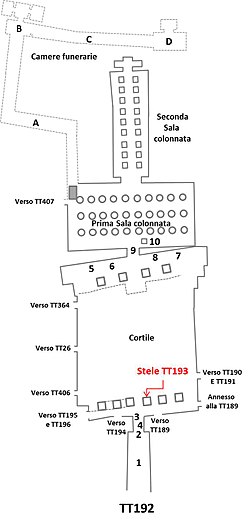
El-Assasif is a necropolis near Luxor on the West Bank at Thebes, Egypt, Upper Egypt. It is located in the dry bay that leads up to Deir el-Bahari and south of the necropolis of Dra' Abu el-Naga'.

Tomb TT192, located in the necropolis of El-Assasif in Thebes, Egypt, is the tomb of Kheruef, also called Senaa, who was Steward to the Great Royal Wife Tiye, during the reign of Amenhotep III. It is located in El-Assasif, part of the Theban Necropolis.

The ancient Egyptian noble Pabasa was chief steward of the God's Wife of Amun Nitocris I during the Saite Period. He is buried in tomb TT279, which is located in the El-Assasif, part of the Theban Necropolis, near Thebes.
The Theban Tomb TT36 is located in El-Assasif, part of the Theban Necropolis, on the west bank of the Nile, opposite to Luxor. It is the burial place of the ancient Egyptian Ibi, who was "Chief Steward of the Adorer of the God", during the reign of Psamtik I during the 26th dynasty.
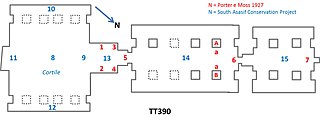
The Theban Tomb TT390 is located in South El-Assasif, part of the Theban Necropolis, on the west bank of the Nile, opposite to Luxor. It is the burial place of the ancient Egyptian female scribe and Chief attendant of the Divine Adoratrice of Amun, Nitocris I, Irterau. Irterau lived during the reign of Psamtik I She was the daughter of the Divine Father of Amun Ipwer and his wife Tashaiu. In the court of the tomb her grandfather Zeho is also mentioned. Zeho was also a Divine Father of Amun.

The Theban Tomb TT37 is located in El-Assasif. It forms part of the Theban Necropolis, situated on the west bank of the Nile opposite Luxor. The tomb is the burial place of the ancient Egyptian Harwa, who was Chief Steward of the God's Wife of Amun, Amenirdis I, during the 25th Dynasty. Harwa was the son of the scribe Pedemut and his wife Estawert.

Tomb TT196, located in the necropolis of El-Assasif in Thebes, Egypt, is the tomb of Padihorresnet, who was a chief steward of Amun during the Twenty-sixth Dynasty of Egypt. Padihorresnet's tomb is part of the TT192 tomb complex.
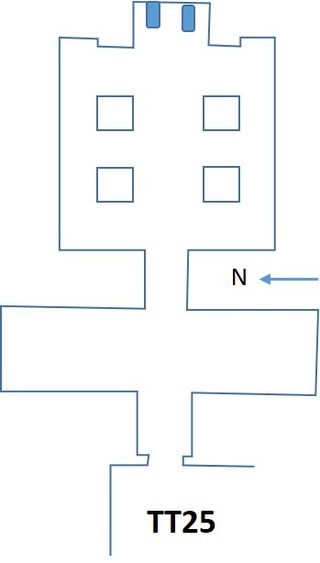
The Theban Tomb TT25 is located in El-Assasif. It forms part of the Theban Necropolis, situated on the west bank of the Nile opposite Luxor. The tomb is the burial place of the ancient Egyptian official, Amenemhab.
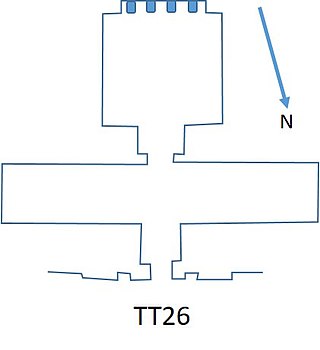
The Theban Tomb TT26 is located in El-Assasif, part of the Theban Necropolis, on the west bank of the Nile, opposite to Luxor. It is the burial place of the ancient Egyptian official, Khnumemhab.
The Theban Tomb TT34 is located in El-Assasif. It forms part of the Theban Necropolis, situated on the west bank of the Nile opposite Luxor. The tomb is the burial place of the ancient Egyptian official, Mentuemhat (Montuemhat).

The Theban Tomb TT391 is located in South El-Assasif, part of the Theban Necropolis, on the west bank of the Nile, Egypt, opposite to Luxor. It is the burial place of the ancient Egyptian mayor of Thebes and fourth priest of Amun Karabasken, who lived during the reign of the 25th Dynasty pharaohs Piye and Shabaka. The tomb itself was built around 715–705 BCE under Shebitku, and it is the earliest one in South El-Assasif. It was first discovered in 1820 by John Gardner Wilkinson, Robert Hay and James Burton, then by Karl Richard Lepsius; it was reopened in 2001.

Theban Tomb TT223 is located in South El-Assasif. It forms part of the Theban Necropolis, on the west bank of the Nile opposite Luxor. The site is the burial place of the ancient Egyptian Karakhamun. It was first discovered in 1820 by Wilkinson, Hey and Burton, then by Lepsius, it was reopened in 2001.
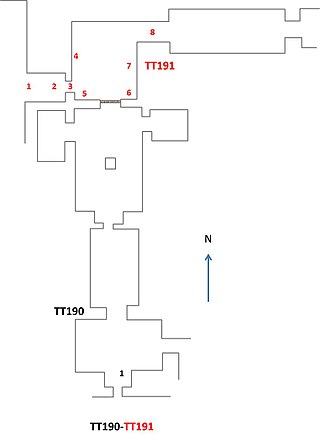
Tomb TT191, located in the necropolis of El-Assasif in Thebes, Egypt, is the tomb of Wahibre-Nebpehti, who was the chamberlain of the Divine Adoratrice of Amun and the director of the festival from the time of Psamtik I.

Tomb TT190, located in the necropolis of El-Assasif in Thebes, Egypt, is the tomb of Esbanebded and part of the TT192 tomb complex.
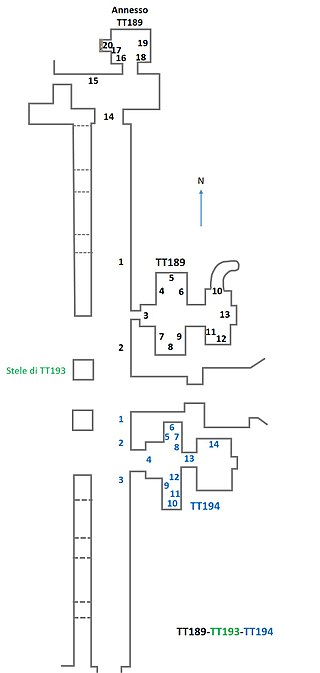
Tomb TT193, located in the necropolis of El-Assasif in Thebes, Egypt, is the tomb of Ptahemheb, who was a magnate of the seal in the treasury of the Estate of Amun during the Nineteenth Dynasty of Egypt. Ptahemheb's tomb is part of the TT192 tomb complex. A stele from the tomb is located in the courtyard of the tomb of Kheruef (TT192)

Tomb TT194, located in the necropolis of El-Assasif in Thebes, Egypt, is the tomb of Thutemhab (Djehutyemhab), who was an overseer of the marshland-dwellers of the Estate of Amun and a scribe in the temple of Amun during the Nineteenth Dynasty of Egypt. Thutemhab's tomb is part of the TT192 tomb complex.

Tomb TT195, located in the necropolis of El-Assasif in Thebes, Egypt, is the tomb of Bekenamun, who was a scribe in the treasury of the Estate of Amun during the Nineteenth Dynasty of Egypt. Bekenamun's tomb is part of the TT192 tomb complex.

The Theban Tomb TT388 is located in El-Assasif, part of the Theban Necropolis, on the west bank of the Nile, opposite to Luxor.

Tomb TT407, located in the necropolis of El-Assasif in Thebes, Egypt, is the tomb of Bintenduanetjer, who was the Chamberlain of the Divine Adoratrice, and dates to the Saite period.
